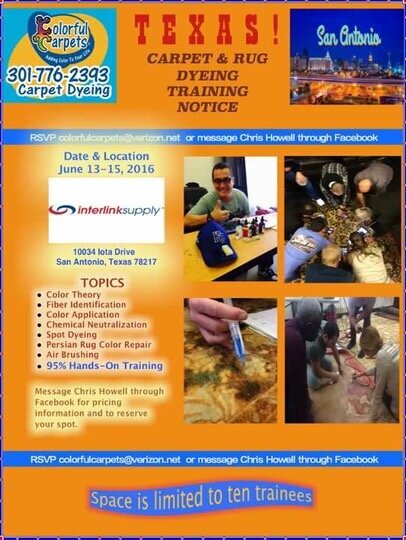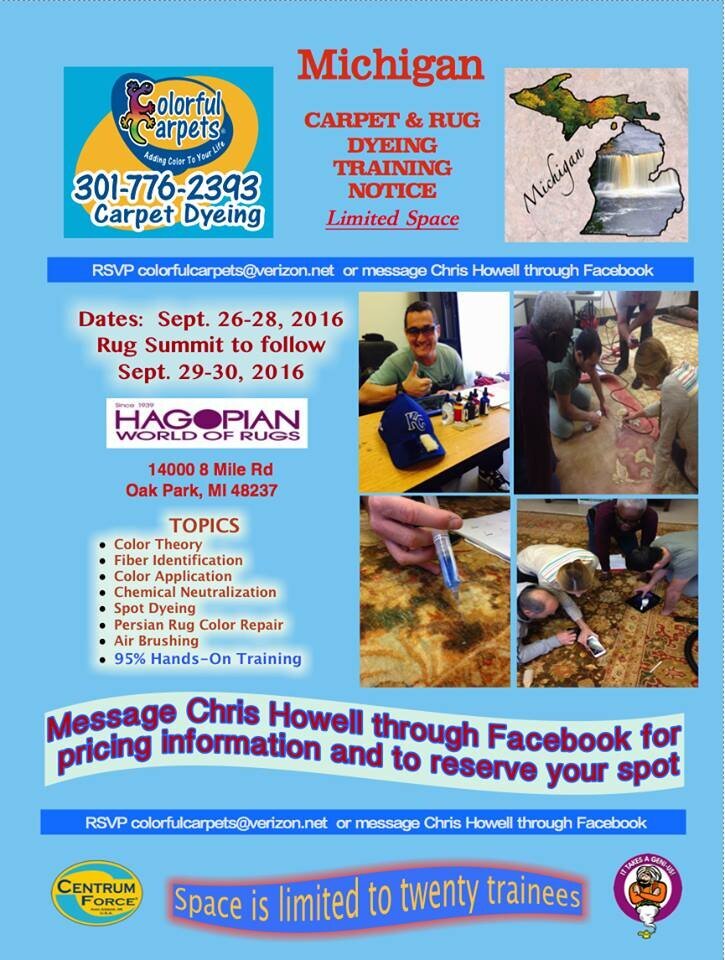Thank you Scott and Melody !
Here i the information I was passed, Hope it is okay to share
Taken from the following:
Production Manual
The Society of Cleaning Technicians
706 N Main Street
PO Box 3688
Greenville, SC 29808
Crayola – The $1.97 Color Spotting Tool
Prepared from material presented by Mr. Murray Cremer. Cremer’s Rug & Upholstery Cleaner, Long Beach, CA., Joint ASDS, Int. / Calf. CARPET CLEANERS Technical Seminar, Santa Monica, CA., September 1974
The Crayola Technique for spotting carpets is convenient and portable means of restoring the color to small spots sometimes encountered when cleaning carpets and upholstery. The techniques suggested here are available for both professional and home use.
The term “small spots”, means, as examples, those spots which typically would result from dripping chlorine bleach on a
deep blue plush, a small animal urinating on a light beige high-low, or residual shoe polish on a white shag. The Crayola technique is not intended for large scale color repairs.
The tools required would include the following: The giant size box of Crayola. A spray bottle of chlorinated solvent, such as l.l.l. trichloroethylene. Also required is a functional household type steam iron, several pieces of heave Kraft paper, a bone scraper, and a supply of wiping towels, (white of course).
Personally, the operator should have a reasonable understanding of basic color composition. Illustrated in figure 1 and how colors can mix to produce other colors. With Crayola the colorist is working with a wax which contains pigments or dyes. Some colors will be a combination of pigments and dyes. Others will be pigments or dyes. Most likely white and black will be on ly pigment and wax. The white crayon is likely to contain titanium dioxide as the pigment Carbon black is likely to be the pigment in the black crayon. The wax used in Crayola has a very low melt point.
The basic idea is to wet out the spot with solvent, and to keep the spot wet as long as necessary to make the desired color match. The solvent ?ubilizes the color containing wax. When dissolved, the color can be spread as desired.
Of course, test the particular solvent to be used before commencing. Will the solvent damage the backing adhesive, carpet, yarn, or adjacent color? In any event, spray only that amount of solvent sufficient to keep the working area damp. Do not spray in excess which will only drain downward into the backing adhesive. Some proprietary solvents will contain a diluent. The presence of a diluent retards evaporation and provides longer working time. ? the colorist will not have to spray as often.
A light spray frequently is better than a heavy occasional spray.
How is it done? Simple! Just spray on the solvent and start coloring. Start with a shade lighter than that ultimately desired. Work up to the darker shade gradually. Combine colors as necessary to yield the desired shade.
REMEMBER: It is easier to add color than to remove color!
It is just like mixing paint. For instance: Starting with a yellow or gold spot in an otherwise green shag, the operator should start a blue crayon and not he green crayon, Blue and yellow makes green. The color composition chart at Figure 1, can be a general guide for mixing crayons to produce a particular color or shade.
Need a deeper tone? Spray more solvent to maintain a dampness in the nap. Apply a different color in the range desired.
Need a lighter shade? Try the white or a pastel crayon.
When the color dries, if the spot is too shiny cover the spot with Kraft paper and rub with the steam iron. For this purpose, the steam iron should be used dry and set at the lowest temperature setting.
Should the color be washed away from the surface by some subsequent event, try this: Use a steam iron. Use the iron wet. Hold the iron about 2” away from the spot and spray spot lightly with steam. As the steam evaporates, the softened color should migrate back to the tips of the fibers.
The 65 color box of Crayola costs only $1.97. Use the crayons straight, or blend one, two, or three colors at will. Color spots for revenue, to make a friend, or to show the customer how. Small spots should not be permitted to detract from the overall beauty of any carpeted floor or piece of upholstered furniture. The $1.97 box of Crayola should be standard equipment for every professional carpet and upholstery cleaner.
Alex J Twist: 10/74 – updated: 11/74
[1] CRAYOLA is a trademark of Binney & Smith, Inc., New York 10017
C. Lee







